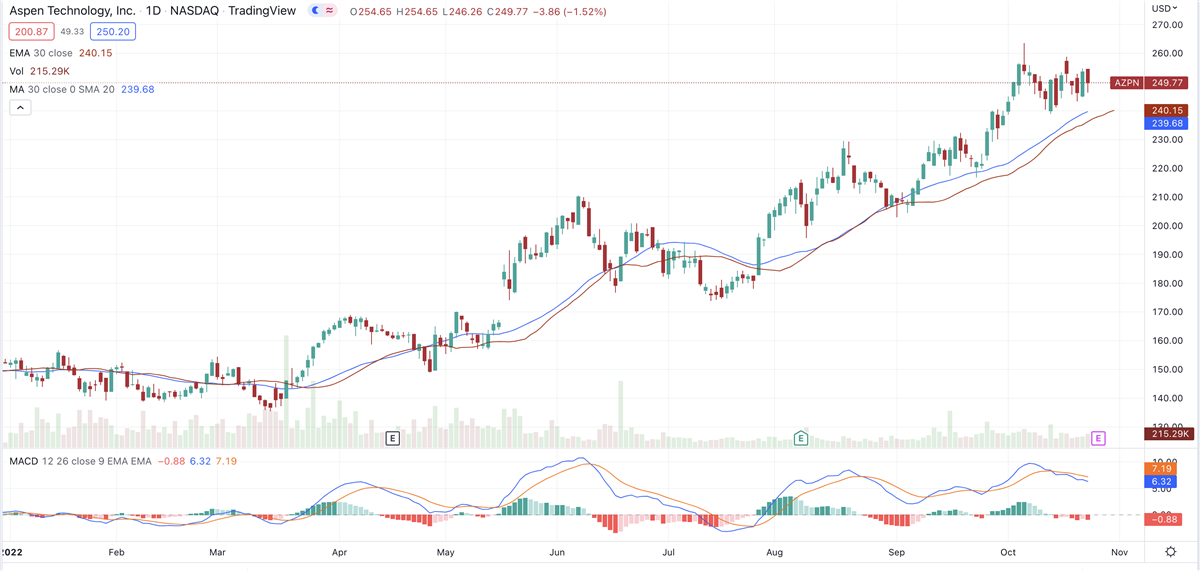 Enterprise software specialist Aspen Technology (NASDAQ: AZPN) has formed a potentially bullish pennant pattern as it pulls back slightly from its October 6 high of $263.59.
Enterprise software specialist Aspen Technology (NASDAQ: AZPN) has formed a potentially bullish pennant pattern as it pulls back slightly from its October 6 high of $263.59. Its weekly chart shows a trend of higher lows and lower highs over the past few weeks, ahead of the company’s fiscal first quarter report on Wednesday. Wall Street expects the maker of plant operations and supply chain management software to earn $1.09 per share on revenue of $227.97 million, increasing over the year-earlier quarter.
The bullish pennant can occur as investors take a breather following a big rally before there’s another catalyst, such as earnings. It could potentially send the price higher.
According to MarketBeat earnings data, AspenTech missed revenue expectations in the past three quarters. That didn’t stop investors from piling into the stock, sending it higher in numerous short- and longer-term rolling timeframes. Recent returns are as follows:
- One month: +12.60%
- Three months: +39.13%
- Year-to-date: +66.65%
- One year: +58.59%
AspenTech is part of the enterprise software sub-industry within the tech sector. It has a market capitalization of $16.64 billion. That qualifies as a large cap, but with so many bigger companies on the market, it’s not yet part of the S&P 500.
It’s part of a somewhat glamorous industry, given that several large enterprise-software peers like Salesforce (NYSE: CRM), ServiceNow (NYSE: NOW), Snowflake (NYSE: SNOW), Shopify (NYSE: SHOP) and Datadog (NASDAQ: DDOG) are all large caps that posted strong run-ups in 2020 and 2021. Those stocks became well-known among growth investors and Aspen remained in stealth mode.
Much of that was due to its smaller market cap. Being a component of the S&P 500 means a stock automatically attracts more institutional investors as funds tracking that index must hold positions commensurate with index weightings.
However, as most stocks in that industry stumbled, Aspen took off. In early 2022, as the broader market and techs were among the biggest decliners, Aspen held steady. The stock traded in a tight range between November 2021 and March of this year, then began rallying in earnest in May.
Aspen’s business itself is somewhat more obscure, another factor in its low profile among tech investors until just a few months ago. The company helps enterprise clients optimize its digital assets to run assets safer, greener, longer and faster.
Energy and Industrial Customers
Rather than serving prominent techs or consumer-facing businesses, AspenTech has a customer base that includes the chemical and energy industries.
In October of last year, industrial technology and engineering firm Emerson Electric (NYSE: EMR) took a 55% stake in Aspen, with a valuation of $6 billion. That transaction closed in May. Two Emerson software units were wrapped into AspenTech.
The Emerson deal will also help Aspen make inroads in new industries like pharmaceuticals and expand into China.
Aspen has had an uneven earnings and revenue growth history. In the past four quarters, revenue results ranged from a year-over-year decline of 64% to a year-over-year gain of 209%.
Its three-year revenue growth rate of -8% reflects that uneven performance.
Irregular Earnings Growth Rates
Earnings have also grown at irregular rates. The company has been profitable for years, but earnings fell in 2020, from $4.11 per share to $3.78 per share. Its three-year earnings growth rate is -6%.
Despite that negative growth rate, Wall Street expects more going forward. Analysts see earnings coming in at $6.77 per share for fiscal 2023, a gain of 49%. In fiscal 2023, it has risen another 13% to $7.62 per share.
According to MarketBeat analyst data, the consensus rating on the stock is “moderate buy.” Because of the strong recent run-up, a pullback could happen in the not-so-distant future as investors pocket profits. It’s always wise to wait for an earnings release as is the case with AspenTech.





